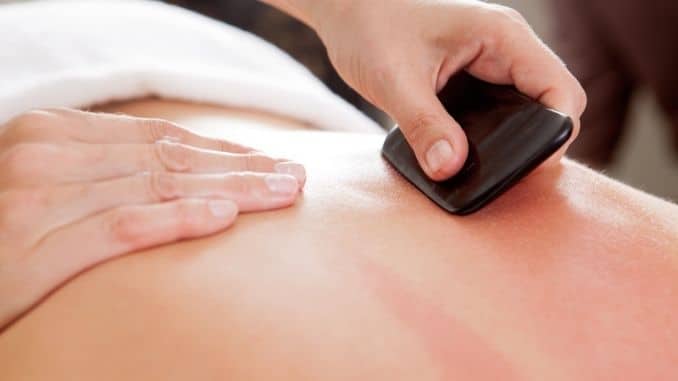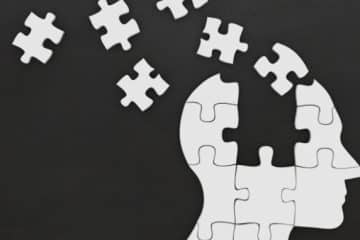Gua Sha is an ancient technique where the skin is scraped with a blunt-edged tool to produce a therapeutic effect. “Gua” means the process of scraping the skin, and “Sha” is the petechiae, or the redness that is create.
With Gua Sha, we take super short or very long strokes that are scraped on the skin. This helps to increase local circulation and breaks up scar tissue and/or adhesions in the muscles and connective tissue. It can help to release unhealthy bodily matter from blood stasis within sore, tired, stiff, or injured muscles.
It can help stimulate new oxygenated blood flow to the areas. This helps to promote metabolic cellular repair, regeneration, healing, and recovery.
Gua Sha can be done anywhere on the body, but most commonly on the back, neck, and shoulders, as well any areas of non-acute trauma, like elbows, knees, and ankles.
Gua Sha is good for any type of sprain and plantar fasciitis. It helps improve blood flow to the area, stretch ligament tears and promote healing.
Is Gua Sha Painful?
Gua Sha is comfortable and some people do enjoy it… almost like a “It hurts so good” kind of feeling. Obviously, the deeper you go, the more uncomfortable it is.
Tools used in Gua Sha
- Honey Jar Lid
- Jade Blades
- Spoon
- Graston – This tool comes in different shapes and sizes. Longer ones are use for bigger areas on the body. Curved ones are usually for the knees.
- Brass Knuckles – This tool is good for shoulders and knees as it is easily move around bony prominences and is easy to hold. Besides, it has amazing therapeutic benefits and can cover a large surface area easily.
- Shonishin Tool – This tool is typically use for infants, babies, or small children and it can help with colic, constipation, insomnia, and skin conditions.
Benefits of Gua Sha
- Respiratory Conditions – (i.e. common cold, sore throat, tension headache). In Chinese medicine, it is believe that pathogens (like in common colds) enter the body through the back of the neck, and scraping where the pathogen entered can help to vent it out completely.
- Infection – Gua Sha can alter the course of any acute infectious illness. Moreover, it can even reduce inflammatory symptoms in chronic illness.
- Acute or Chronic Pain – Basically, in Traditional Chinese Medicine (TCM), pain is often cause by a stagnation of blood in the local areas. Besides, the guiding principle behind Gua Sha is its ability to break up the stagnation to promote the smooth flow of blood in the area, thereby relieving pain.
Theories behind Gua Sha:
- Microcirculation that is enforce with Gua Sha in the soft tissue helps to nourish the tissues and potentially stagnates the body’s natural pain-relieving opioid system. It blocks the pain response pathways, thus, pain relief is felt almost immediately.
- Based on the most recent research, Gua Sha regulates gene expression for an enzyme that has an antioxidant in situ protectant, called oxygenase 1 or HO1. Moreover, scraping the skin regulates the gene expression which helps to protect the cells.
- In one of the most famous studies included two controlled groups that had severe neck pain. One controlled group only used heat for one hour a day for a week. The other controlled group received 10 minutes of Gua Sha on their neck every day for the same week. Results revealed that people who received the Gua Sha were almost completely pain-free as compared to the people who used heat for pain relief.
- Doppler imaging has been used to show microcirculation is indeed increased in treated areas.
Uses of Gua Sha
- Gua Sha is often use to remove heat from the body. In addition, this can be include fever, a bad cold, or a pounding headache accompanied by heat and dry mouth. It can also treat menopausal women suffering from hot flushes and night sweats.
- Gua Sha has helped to realign the fascia. This is one of the reasons that it works so well for muscle pain. When you experience trauma, your fascia can appear misaligned under a microscope. If you use this in the direction of the muscle fibers that the fascia is situate over, it can help to realign those fibers.
Contraindications:
- Anyone with deficiencies like cancer, Parkinson’s Disease, people with thin blood or those prone to bruising
- People on blood thinners, those with bleeding disorders, leukemia, severe anemia,
- Severe acute cardiovascular diseases
- Acute ligament or tendon injuries or new bone fractures. For ligament and tendon sprains, you need to wait until after the acute phase passes.
- Local scarring or areas where a malignant tumor is removed
- Lower abdomen
- Lumbosacral or lower back of a pregnant woman
- Infectious skin diseases such as skin lesions in diabetic patients, severe varicose veins of the leg, and open wounds
Adrienne Coombs was born and raised in Nelson, British Columbia. She began her education with a degree in Kinesiology at Langara College in Vancouver, B.C. Following this, she studied Traditional Chinese Medicine at the Academy of Classical Oriental Sciences in her hometown of Nelson, where she finished a 5- year Doctorate of TCM.
Currently, she is a Traditional Chinese medicine practitioner and Sports Medicine Acupuncturist at Pro Motion Clinic at British Columbia, Canada.
Discover the proven secret weapon for nautrally staying young. Click here for more info.
Unlock Your Youthful Glow with Our 14-Day Anti-Aging Quick Start Program!
Are you ready to turn back the clock and embrace a more youthful, radiant you? Join our exclusive 14-Day Anti-Aging Quick Start Program and discover the secrets to revitalizing your skin, boosting your energy, and feeling fabulous at any age!





